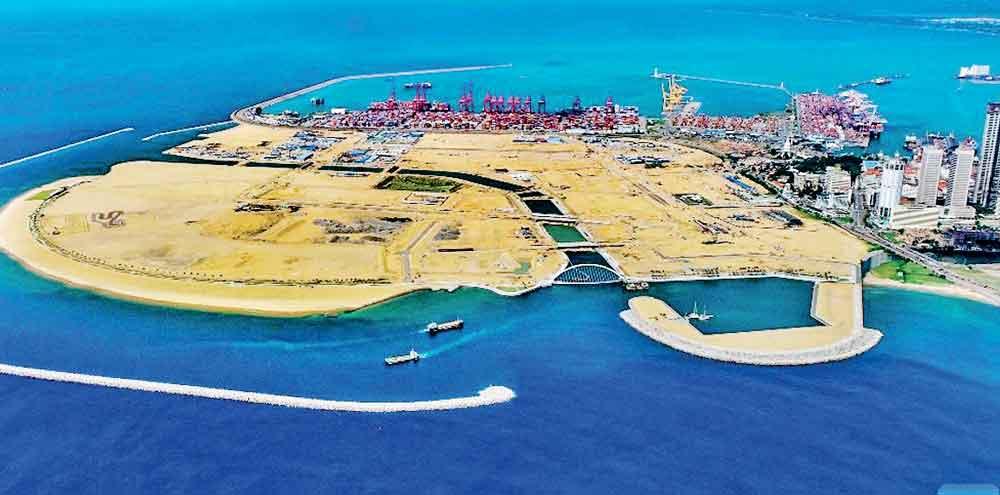Reply To:
Name - Reply Comment

Labour laws have also been watered down within the Port City.
A fact that is skillfully unaddressed is that the Port City has not attracted any major principal investor so far
It has attracted over 100 secondary companies to register and operate within its borders, enjoying all incentives and tax holidays, with a relaxed timeframe to meet their employment obligations and revenue thresholds. For example, although they are supposed to employ a minimum of 100 people and have a valuation of at least $500,000, they have also been given five years to meet these conditions
The developers of the Port City claim to have spent $1.5 billion on reclamation and development, but industry experts believe this figure to be exaggerated. The cost of reclamation worldwide is typically much lower, leading to questions about where the funds have been directed to
Investors prioritise factors such as macroeconomic stability, access to skilled labour, and quality infrastructure facilities when making investment decisions
 With the victory of Anura Kumara Dissanayake (AKD), Sri Lanka sees a ray of hope in eradicating corruption and increasing political accountability. The people of Sri Lanka are confident that it will be their interests that will be paramount for the new President.
With the victory of Anura Kumara Dissanayake (AKD), Sri Lanka sees a ray of hope in eradicating corruption and increasing political accountability. The people of Sri Lanka are confident that it will be their interests that will be paramount for the new President.
Behind the scenes of the elections hubbub, the desolate Colombo Port City has been gathering media attention over the last month, given the ‘milestone’ of onboarding 100 (secondary) investors and the opening of The Mall.
However, a fact that is skillfully unaddressed is that the Port City has not attracted any major principal investor so far. It has attracted over 100 secondary companies to register and operate within its borders, enjoying all incentives and tax holidays, with a relaxed timeframe to meet their employment obligations and revenue thresholds. For example, although they are supposed to employ a minimum of 100 people and have a valuation of at least $500,000, they have also been given five years to meet these conditions. During this period, they can continue to enjoy all the tax benefits and incentives without any scrutiny or review. This delayed accountability raises serious questions about the genuine impact of these investments on job creation and the broader economy.
Several critics also argue that existing companies are in fact re-registering under new names to take advantage of the tax incentives, without changing the core operations of their businesses. Unlike their counterparts outside the special economic zone, the companies that will set up shop in Sri Lanka will enjoy a 25-year exemption from corporate taxes. As a result, companies are exempted from paying indirect taxes, such as the Value Added Tax (VAT), withholding taxes, and dividend taxes. Additionally, goods imported into the Port City are not subject to customs duties or border tariffs like CESS and PAL. All of this, despite economic evidence suggesting that tax incentives are not the most important factor attracting FDI. Rather, investors prioritize factors such as macroeconomic stability, access to skilled labour, and quality infrastructure facilities when making investment decisions.
At a time when a new President has been elected on an anti-corruption, pro-welfare plank, having such sweeping exemptions for the Port City as opposed to the rest of Sri Lanka only shifts burden to the very support base who voted for change.
Labour laws have also been watered down within the Port City. Companies operating within are able to hire and dismiss employees without following the stringent labour regulations that apply to other businesses in the country. This lack of oversight has raised alarms about the treatment of workers and the eventual erosion of labour rights, further distancing the Port City from the national regulatory framework.
During a period in which Sri Lanka needs to enhance its employment, the Port City appears to provide gateways for employment of more foreign nationals as well as shifting employment from currently taxed jobs outside Port City to income tax-free jobs within the Port City.
The developers of the Port City claim to have spent $1.5 billion on reclamation and development, but industry experts believe this figure to be exaggerated. The cost of reclamation worldwide is typically much lower, leading to questions about where the funds have been directed to. Critics suggest that the Port City project is more about benefiting Chinese interests and the vested interests of leading political actors behind the scenes.
It is still too early to gauge how the newly elected President and his administration will revise the Port City regulations for the benefit of the people lest it be a drain on Sri Lanka’s resources.